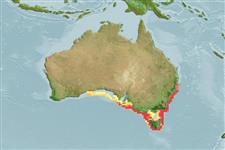Elasmobranchii (sharks and rays) >
Rajiformes (Skates and rays) >
Arhynchobatidae (Softnose skates)
Etymology: Pavoraja: Latin, pavo = peacock + Latin, raja, -ae = a sting ray (Raja sp.) (Ref. 45335).
More on author: Günther.
Environment: milieu / climate zone / depth range / distribution range
Ecology
Marine; demersal; depth range 30 - 390 m (Ref. 6871). Temperate; 30°S - 44°S, 126°E - 154°E (Ref. 114953)
Eastern Indian Ocean: endemic to Australia (South Australia to New South Wales).
Length at first maturity / Size / Weight / Age
Maturity: Lm 31.9, range 31 - 33 cm
Max length : 36.8 cm TL male/unsexed; (Ref. 76878)
Occur over soft bottoms of the continental shelf (Ref. 7300, 75154). Oviparous. Distinct pairing with embrace. Young may tend to follow large objects, such as their mother (Ref. 205). Eggs are oblong capsules with stiff pointed horns at the corners deposited in sandy or muddy flats (Ref. 205). Egg capsules are 5.7 cm long and 3.8-4.4 cm wide (Ref. 41308). Both sexes reaches maturity at ca. 30-33 cm TL; hatch size at ca. 8 cm TL. Biology poorly known. Discarded bycatch of local trawl fisheries (Ref. 114953).
Life cycle and mating behavior
Maturities | Reproduction | Spawnings | Egg(s) | Fecundities | Larvae
Oviparous, paired eggs are laid. Embryos feed solely on yolk (Ref. 50449). Distinct pairing with embrace. Young may tend to follow large objects, such as their mother (Ref. 205).
McEachran, J.D. and K.A. Dunn, 1998. Phylogenetic analysis of skates, a morphologically conservative clade of elasmobranchs (Chondrichthyes: Rajidae). Copeia 1998(2):271-290. (Ref. 27314)
IUCN Red List Status (Ref. 130435)
Threat to humans
Harmless
Human uses
Tools
Special reports
Download XML
Internet sources
Estimates based on models
Preferred temperature (Ref.
123201): 12.5 - 17.3, mean 14.6 °C (based on 89 cells).
Phylogenetic diversity index (Ref.
82804): PD
50 = 0.5156 [Uniqueness, from 0.5 = low to 2.0 = high].
Bayesian length-weight: a=0.00550 (0.00273 - 0.01106), b=3.10 (2.93 - 3.27), in cm total length, based on LWR estimates for this (Sub)family-body shape (Ref.
93245).
Trophic level (Ref.
69278): 3.7 ±0.7 se; based on size and trophs of closest relatives
Resilience (Ref.
120179): Low, minimum population doubling time 4.5 - 14 years (Fec assumed to be <100).
Fishing Vulnerability (Ref.
59153): Low to moderate vulnerability (27 of 100).
